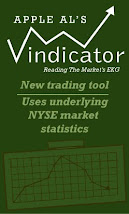Continuing with last week's theme that an Intermediate Term top is either nearby are already in, the short term EW counts look like this:
Alternate #1 - IT top nearby
Alternate #2 - IT top in at Dec 31 high
In Alt #1, the count shows a double zig-zag off last Monday's lows for a "B" wave of a Minute W4 flat in progress. EW rules will allow for as much as 3 zig-zags in a multiple zig-zag move, so the possibility of another upward thrust is open. If that occurs, and if new highs are achieved, then Alt #2 is disqualified. Also, there is the possibility that the entire mess off last Monday's lows is some sort of leading diagonal wave 1, in which case both these alternates would be ruled out and a far different short term scenario presents itself. But let's save that possibility for analysis if it occurs.
-----------------------------------------------------------------------------------------------------------------
The Tick trading system looked pretty darn good in the chart presented last week:
To review the trading rules: trade signals need two things to happen, a cross by the blue SMA above (buy signal) or below (sell signal) the red SMA, and a Heikin-Ashi bar in the direction of the indicated trend. Stop losses are set at a distance of 1 ATR from the closing price of the bar where the trade was initiated. In the period reviewed last week, which was the 20 trading days ending Jan 3, there were 6 completed trades with 4 winners and 2 losers, net gain of 69.97 points with a max drawdown of 15.44 points.
As mentioned in last week's post, a trading approach like this needs a good 12 months of tracking before a definitive judgement can be made on it's utility. The results in the last week on this system are a good illustration of why this is necessary:
As can be seen, the system got into some pretty serious whipsaws, and the results for the 20 day period ending Jan 10 are 4 winners and 6 losers, only 15.07 net gain with a max drawdown of 18.50 points. Not nearly as impressive as it looked a week ago, or rather, impressive in the other direction.
So what happened, and can anything be done about it? My read on the situation is that the activity of the last couple of weeks is reflecting a lack of strong conviction by both the bulls and the bears, so the result is indecision and a sideways market. This is actually quite interesting, because the pattern in prices and the pattern in the Tick analysis reflect each other. What can be done from a trading standpoint? I think the answer can be found in the lyrics of an old song: "You've got to know when to hold 'em, know when to fold 'em" (The Gambler - Kenny Rogers). In this situation, it's time to back away from the table.
Applying that thought to the Tick trading system, the thing that is of use can be found in the histogram. That chart represents the spread between the two moving averages employed. The rule considered is that trading signals should be ignored if the histogram doesn't generate a reading above 25 or below -25 for for more than 26 bars. Why 26? Because that's the time period used in the MA's employed. Why 25 to -25? Honestly, because that looked about right when examining the chart. If eventually this rule is determined to be a keeper, then the appropriate trigger levels should also be tested and refined.
Applying this new rule to the most recent twenty days results in a marked improvement:
As can be seen, the adjusted system now shows 4 completed trades, with 3 winners and 1 loser, 32.02 points net gain with 12.89 max drawdown.
When developing a trading system, a danger is making up rules for every negative situation that occurs. There is that danger here, but I believe it's not yet a concern. In this particular case, it is true that markets often go into a sideways mode, and that will present the danger of whipsaws. Especially with a system based on moving averages. So it seems appropriate that the issue be addressed and a means of handling it be developed.





